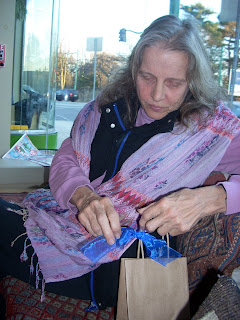
It seems everything comes with a warning label or an advertisement, every banana, every apple with a sticker, every box of strawberries with a website printed on its tag. The other day I noticed a cart for the disabled in Whole Foods onto which was bolted a sign that said in effect: 'We provide this because we value our customers.' But nothing beats the warning label on the Pyrex storage containers I just bought, which are addressed to people with no experience with glass, the plastic generation.
Among other things, the manufacturers warn us not to drop glass. Is there anyone who has not dropped something made of glass! "It's legal," you may say. Pyrex protects itself against lawsuits, but the result in fine print reads like the anxieties of someone insanely terrified of glass. It's enough to make me drink a glass of wine and fling the empty glass against a hard surface. I bought these glass containers because of the threat of bisphenol A, which coats most plastics and the insides of tin cans. Canada has already banned this chemical which may cause dreadful mutations, but I hadn't realized what a dangerous thing I had done.
Here is my favorite section of the detailed warning:
Be careful when handling broken glass because pieces may be extremely sharp and difficult to locate. Handling your glassware without an appropriate degree of care could result in breakage, chipping, cracking or severe scratching. DO NOT use or repair any glassware that is chipped, cracked or severely scratched. DO NOT drop or hit glassware against a hard object or strike utensils against it.
There's more:
SAFETY AND USAGE INSTRUCTIONS AND WARRANTIES. Read these instructions and Save them for Future Reference. For more information, visit www.pyrexware.com or call the World Kitchen Help Center . . . . As with all glass products, you must exercise an appropriate degree of care, especially when cooking food at high temperatures. There are three primary risks associated with using glassware for cooking: (1) breakage due to a sudden temperature change applied to the glassware; (2) breakage due to impact if the glassware is dropped or knocked against a hard object; and (3) burning when handling hot bakeware. ! FAILURE TO FOLLOW THE WARNINGS BELOW MAY RESULT IN PERSONAL INJURY OR PROPERTY DAMAGE, OR MAY CAUSE YOUR GLASSWARE TO BREAK OR SHATTER IMMEDIATELY OR LATER. Avoid sudden temperature changes to glassware. DO NOT: add liquid to hot glassware; place hot glassware on a wet or cool surface, directly on countertop or metal surface, or in sink; or handle hot glassware with wet cloth. Allow hot glassware to cool on a cooling rack, potholder or dry cloth. Be sure to allow hot glassware to cool as provided above before washing, refrigerating or freezing. Oven must be preheated before inserting glassware. DO NOT use on or under a flame or other direct heat source, including on a stovetop, under a broiler, on a grill or in a toaster over. Add a small amount of liquid sufficient to cover the bottom of the dish prior to cooking foods that may release liquid. Avoid handling hot glassware (including ware with silicone gripping surfaces) without dry potholders. Avoid microwave misuse. DO NOT ue glassware to microwave popcorn or foods wrapped in heat-concentrating materal (such as special browning wrappers), heat empty or nearly empty glassware in microwave or overheat oil or butter in microwave (use minimum amount of cooking time.)


















































